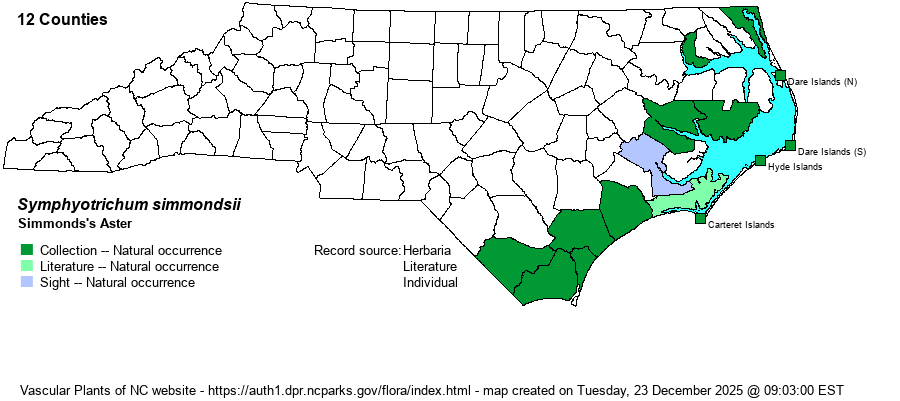| Author | (Small) G.L. Nesom | |
| Distribution | Outer Coastal Plain and Outer Banks/barrier islands. This is at least part of the former Aster racemosus in RAB (1968), but for whatever reason, this taxon -- "Aster racemosus" -- seems to have been ignored or passed over in some recent references, including Weakley (2018).
Coastal Plain, NC to southern FL and AL. To be looked for in VA. | |
| Abundance | Generally uncommon to infrequent in its narrow coastal range, but may be locally common. This is a Watch List species. | |
| Habitat | Moist soils of maritime interdune swales, interdune marshes, maritime wet grasslands, wet pine flatwoods, roadside ditches. | |
| Phenology | Flowering and fruiting September-November. | |
| Identification | Simmonds's Aster is yet another member of the "small white aster" group. It often grows taller -- to 4.5 feet -- and usually is colonial via long horizontal rhizomes. As with other similar species, basal and lower stem leaves have withered by flowering time. Stem leaves are lance-shaped to linear, stalkless, margins toothed or not, up to 4 inches long. Inflorescences vary from narrow to broad with strongly ascending branches -- however, most plants have a taller than wider inflorescence, often somewhat narrow. Heads have white to pale bluish rays. The branches have relatively few bract-like leaves, unlike S. dumosum. The plant is generally glabrous, unlike S. pilosum. In general, the flowers in the inflorescence are rather scattered and are not crowded as in most other small white asters. | |
| Taxonomic Comments | This species was not recognized by authors until Guy Nesom resurrected it in the 1990s. However, reviewing the older specimens in SERNEC (some from the 1940s - 1960s), it is clear that some specimens formerly considered as A. racemosus in RAB (1968) are now this "new" species. The identification of NC plants is secure, but there still remain issues with some FL plants -- see Cronquist (1980). Note that the current S. racemosum is the former A. vimineus and not the former A. racemosus.
| |
| Other Common Name(s) | None | |
| State Rank | S2S3 | |
| Global Rank | G4G5 | |
| State Status | W1 | |
| US Status | | |
| USACE-agcp | | |
| USACE-emp | | |

